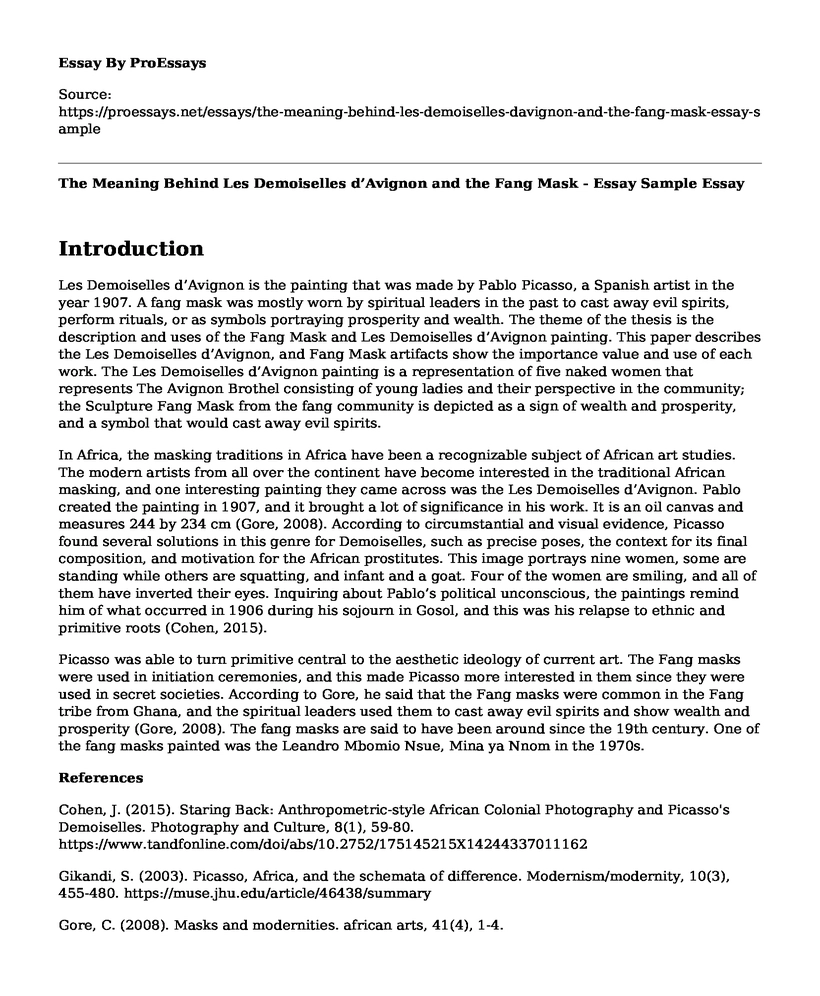Introduction
Les Demoiselles d’Avignon is the painting that was made by Pablo Picasso, a Spanish artist in the year 1907. A fang mask was mostly worn by spiritual leaders in the past to cast away evil spirits, perform rituals, or as symbols portraying prosperity and wealth. The theme of the thesis is the description and uses of the Fang Mask and Les Demoiselles d’Avignon painting. This paper describes the Les Demoiselles d’Avignon, and Fang Mask artifacts show the importance value and use of each work. The Les Demoiselles d’Avignon painting is a representation of five naked women that represents The Avignon Brothel consisting of young ladies and their perspective in the community; the Sculpture Fang Mask from the fang community is depicted as a sign of wealth and prosperity, and a symbol that would cast away evil spirits.
In Africa, the masking traditions in Africa have been a recognizable subject of African art studies. The modern artists from all over the continent have become interested in the traditional African masking, and one interesting painting they came across was the Les Demoiselles d’Avignon. Pablo created the painting in 1907, and it brought a lot of significance in his work. It is an oil canvas and measures 244 by 234 cm (Gore, 2008). According to circumstantial and visual evidence, Picasso found several solutions in this genre for Demoiselles, such as precise poses, the context for its final composition, and motivation for the African prostitutes. This image portrays nine women, some are standing while others are squatting, and infant and a goat. Four of the women are smiling, and all of them have inverted their eyes. Inquiring about Pablo’s political unconscious, the paintings remind him of what occurred in 1906 during his sojourn in Gosol, and this was his relapse to ethnic and primitive roots (Cohen, 2015).
Picasso was able to turn primitive central to the aesthetic ideology of current art. The Fang masks were used in initiation ceremonies, and this made Picasso more interested in them since they were used in secret societies. According to Gore, he said that the Fang masks were common in the Fang tribe from Ghana, and the spiritual leaders used them to cast away evil spirits and show wealth and prosperity (Gore, 2008). The fang masks are said to have been around since the 19th century. One of the fang masks painted was the Leandro Mbomio Nsue, Mina ya Nnom in the 1970s.
References
Cohen, J. (2015). Staring Back: Anthropometric-style African Colonial Photography and Picasso's Demoiselles. Photography and Culture, 8(1), 59-80. https://www.tandfonline.com/doi/abs/10.2752/175145215X14244337011162
Gikandi, S. (2003). Picasso, Africa, and the schemata of difference. Modernism/modernity, 10(3), 455-480. https://muse.jhu.edu/article/46438/summary
Gore, C. (2008). Masks and modernities. african arts, 41(4), 1-4. https://www.mitpressjournals.org/doi/pdf/10.1162/afar.2008.41.4.1
Cite this page
The Meaning Behind Les Demoiselles d'Avignon and the Fang Mask - Essay Sample. (2023, Aug 14). Retrieved from https://proessays.net/essays/the-meaning-behind-les-demoiselles-davignon-and-the-fang-mask-essay-sample
If you are the original author of this essay and no longer wish to have it published on the ProEssays website, please click below to request its removal:
- Social Media Passwords Being Requested in Interviews Essay
- Fight Club Movie Review Paper Example
- The Preservation of Guqin Culture Across Different Generations Paper Example
- Music History Paper Example
- Greek Theater and Black Mirror Essay
- Essay Example on Form Follows Function: Architecture's Founding Father
- Essay on Social Media in the Workplace: How Employers Can Guide its Use







